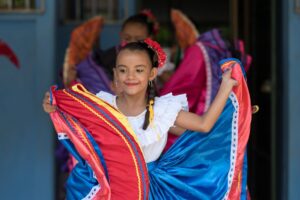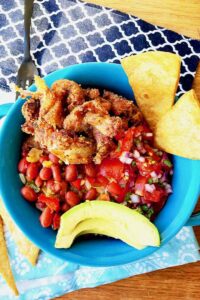Culture
Costa Rica is a small yet vibrant Central American country with cultural diversity and rich heritage. The country is polychronic, meaning that Costa Ricans live according to a system in which time is changed to accommodate their needs (Drexel Education Abroad, 2014). Costa Rica is a captivating country, moving from centuries of history, traditions, and influences from indigenous communities, European settlers, and the African diaspora. Costa Rica’s religion, history, and art make up the uni-cultural and distinct attributes of the people living there. Predominately made up of one culture, one would define it. Costa Rica is considered a high-context culture, meaning they use body language, tone of voice, physical touch, and humor to communicate (Sternquist, 2007). Just like any other culture, Costa Rica has its customs within its society.
Dress
Traditional Costa Rican attire, known as “Campesina” for women, is characterized by vibrant colors and ankle-length skirts (Bateman, 2018); this attire holds deep cultural significance, symbolizing the country’s history and heritage (Figure 10). Men’s traditional attire includes black, denim, or white pants, a red or blue belt, a white shirt, and the iconic white-brimmed “Chonete” hat (News, 2021). This attire represents a fusion of culture, art, and history, connecting Costa Ricans to their ancestral roots and expressing their patriotism to Costa Rica.
Figure 10.
Costa Rican Women’s Traditional Dress.
Figure 11.
Costa Rican Men’s Traditional Attire.
Religion
Religion in Costa Rica intertwines with tradition and culture. Catholicism stands as the state religion, representing 76.3% of Costa Ricans, while around 17% are evangelical protestants. Additionally, diverse religious communities, including small Jewish, Quakers, Jehovah’s Witnesses, and others, coexist with general respect for religious freedom in terms of friendship Patterns where one sees how the people of Costa Rica relate to one another. Traditional festivals like “Semana Santa,” a week-long celebration of Easter, showcase deep-rooted cultural appreciation, reflecting the diverse yet unified nature of Costa Rica (Jordan, 2022). Friendship patterns, influenced by cultural practices and shared experiences such as these festivals, reflect the nature of Costa Rica.
Food
Costa Rican cuisine reflects the country’s heritage and agriculture with delicious flavors. Gallo Pinto, a classic dish made of rice and black beans sautéed with onions and spices, served with eggs, cheese, and fried plantains, is a beloved breakfast staple, as seen in Figure 12 (Garcia, 2023). Another popular dish, “Chifrijo,” found in bars and canteens, includes black beans, white rice, pico de gallo, and crispy pork (chicharrones) (Figure 13). These dishes embody a fusion of flavors and cultural heritage, showcasing the country’s natural resources and diverse culinary influences.
Figures 12 and 13.
Traditional Plates of Costa Rica (Gallo Pinto and Chifrijo).






